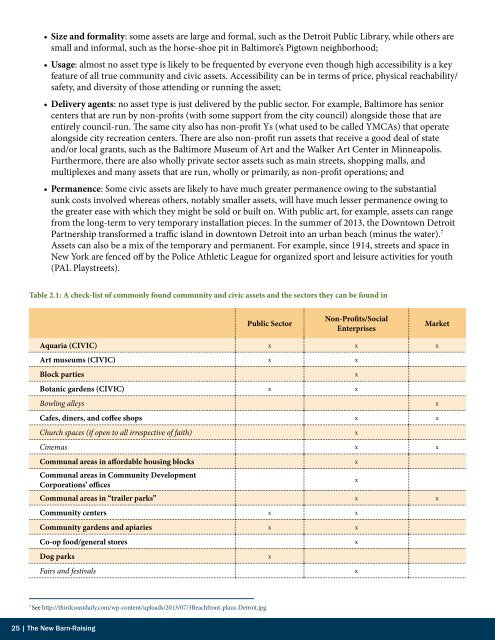bQNs7mR
bQNs7mR
bQNs7mR
Create successful ePaper yourself
Turn your PDF publications into a flip-book with our unique Google optimized e-Paper software.
• Size and formality: some assets are large and formal, such as the Detroit Public Library, while others are<br />
small and informal, such as the horse-shoe pit in Baltimore’s Pigtown neighborhood;<br />
• Usage: almost no asset type is likely to be frequented by everyone even though high accessibility is a key<br />
feature of all true community and civic assets. Accessibility can be in terms of price, physical reachability/<br />
safety, and diversity of those attending or running the asset;<br />
• Delivery agents: no asset type is just delivered by the public sector. For example, Baltimore has senior<br />
centers that are run by non-profits (with some support from the city council) alongside those that are<br />
entirely council-run. The same city also has non-profit Ys (what used to be called YMCAs) that operate<br />
alongside city recreation centers. There are also non-profit run assets that receive a good deal of state<br />
and/or local grants, such as the Baltimore Museum of Art and the Walker Art Center in Minneapolis.<br />
Furthermore, there are also wholly private sector assets such as main streets, shopping malls, and<br />
multiplexes and many assets that are run, wholly or primarily, as non-profit operations; and<br />
• Permanence: Some civic assets are likely to have much greater permanence owing to the substantial<br />
sunk costs involved whereas others, notably smaller assets, will have much lesser permanence owing to<br />
the greater ease with which they might be sold or built on. With public art, for example, assets can range<br />
from the long-term to very temporary installation pieces. In the summer of 2013, the Downtown Detroit<br />
Partnership transformed a traffic island in downtown Detroit into an urban beach (minus the water). 7<br />
Assets can also be a mix of the temporary and permanent. For example, since 1914, streets and space in<br />
New York are fenced off by the Police Athletic League for organized sport and leisure activities for youth<br />
(PAL Playstreets).<br />
Table 2.1: A check-list of commonly found community and civic assets and the sectors they can be found in<br />
Public Sector<br />
Non-Profits/Social<br />
Enterprises<br />
Market<br />
Aquaria (CIVIC) x x x<br />
Art museums (CIVIC) x x<br />
Block parties<br />
x<br />
Botanic gardens (CIVIC) x x<br />
Bowling alleys<br />
x<br />
Cafes, diners, and coffee shops x x<br />
Church spaces (if open to all irrespective of faith)<br />
Cinemas x x<br />
Communal areas in affordable housing blocks<br />
x<br />
Communal areas in Community Development<br />
Corporations’ offices<br />
x<br />
Communal areas in “trailer parks” x x<br />
Community centers x x<br />
Community gardens and apiaries x x<br />
Co-op food/general stores<br />
Dog parks<br />
Fairs and festivals<br />
x<br />
x<br />
x<br />
x<br />
7<br />
See http://thirdcoastdaily.com/wp-content/uploads/2013/07/3Beachfront-plaza-Detroit.jpg<br />
25 | The New Barn-Raising


